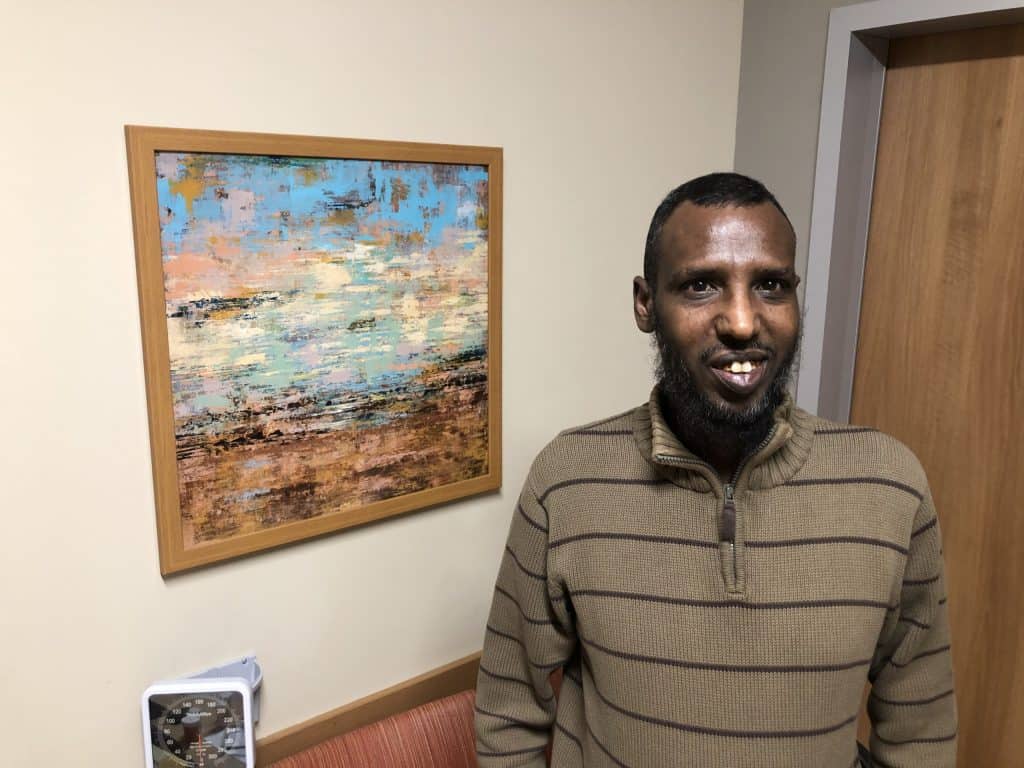ECMO: Improving chances for survival when heart, lungs fail

A knock on his neighbor’s door may have saved Ahmed Warfa’s life. On November 11, the 49-year-old was experiencing chest pain when he went to his neighbor for help.
“That’s the last thing I remember,” he said. “Until I woke up in the hospital.”
Warfa doesn’t recall making the initial 911 call before he passed out, but thankfully his neighbor picked up the phone and called 911 again to make sure help was on the way.
When Hennepin EMS paramedics arrived, they found him with a weak pulse and a shallow breathing pattern. As Warfa was being placed in the ambulance he went into full cardiac arrest. Paramedics gave him several shocks to restart his heart but those were unsuccessful. Cardiopulmonary resuscitation (CPR) was performed throughout the entire trip to HCMC, but when he arrived at the emergency department he still had no pulse and his heart was quivering, a life-threatening cardiac arrest rhythm called ventricular fibrillation. Warfa’s best chance for survival was Extracorporeal Membrane Oxygenation life support – otherwise known as ECMO.
“It’s a complex and specialized treatment available to patients who are experiencing acute respiratory or cardiac failure who are not improving with traditional life support methods,” explains Dr. Matthew Prekker, who directs the program at Hennepin Healthcare.
Hennepin Healthcare has been designated as on the Pathway to Excellence in Life Support by achieving the Silver Level for its ECMO Program by the Extracorporeal Life Support Organization. This recognizes its efforts to provide bedside cardio-respiratory support to critically ill patients utilizing ECMO 24/7/365.
“The ECMO machine actually takes over as a substitute for the heart and lungs when they are not working. It oxygenates blood and removes carbon dioxide outside of the body and then pushes the oxygen-rich blood throughout the body — to the organs that need it most such as the brain and heart.”
It does this through a system of large catheters, tubing, a blood pump, and a thin membrane for gas exchange (similar to a kidney dialysis filter, but for the lungs). Doctors can deploy this system in minutes at the bedside in the HCMC Emergency Department.
“The goal is to get the patient off ECMO and back to his or her own cardiovascular and respiratory function as soon as possible,” said Dr. Prekker. “But in the meantime, ECMO offers excellent support so the care team can treat the underlying problem and stabilize the patient.”
Patients who receive ECMO life support are cared for in the ICU under the direction of medical critical care physicians like Dr. Prekker and other specialists. These doctors work closely with a group of specially-trained, experienced ICU nurses who are responsible for hour-by-hour management of the patient and the ECMO circuit.
In Warfa’s case, while on ECMO support, it was determined that he had clotted off an important coronary artery that feeds the left ventricle, the muscular pumping chamber of the heart. A stent was placed in this artery to restore blood flow, and after three days he was able to be weaned off ECMO life support.
“Patients requiring ECMO have a very high chance of death without the intervention or if we can’t get ECMO started soon enough,” said Dr. Prekker. “But we have developed a unique system in that paramedics alert us if they have a patient in the field with persistent ventricular fibrillation cardiac arrest, and we bring the ECMO circuit to the ED to start life support as soon as the ambulance arrives. Every minute counts in cardiac arrest.”
After spending ten days in the hospital, Warfa was able to go home, grateful to have another chance at life.
“He’s another excellent example of how critical this intervention is for patients experiencing cardiac arrest – which in severe cases like Mr. Warfa’s is something that few would survive without ECMO. Because he received immediate, seamless care with CPR and ECMO his organs continued to receive oxygen even when his heart and lungs weren’t working on their own. That means not only did he survive – but his brain and other vital organs didn’t experience permanent damage. He’s a very fortunate man thanks to his quick-acting neighbor!”
As a leader in medical and surgical critical care, Hennepin Healthcare offers ECMO treatment to help patients recover from critical illness. It’s another one of the advanced interventions available at Minnesota’s first Level I Trauma Center.

